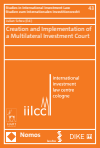Abstract
Starting point of the book is the ongoing reform process on ISDS at UNCITRAL working group III and the proposal to implement an MIC. An introduction sets the stage and provides readers with the latest developments and historical background. On this basis, the following chapters highlight different aspects of creating and implementing an MIC.The chapters cover key elements of the MIC proposal such as the court’s institutional framework, the design of an appeal mechanism, the use of procedures for the settlement of mass claims, and the establishment of an advisory centre for developing countries. In addition, the selection and appointment of judges is discussed. Apart from the court’s structure and procedures, questions of implementation arise. How to integrate the MIC into the current system of ISDS? How can the enforcement of its decisions be ensured? On a political level, the MIC project is based on an initiative of the EU. Therefore, the role of the EU in the reform process is analysed in a separate chapter. Remarks from a practitioner’s perspective round up the contributions. Each chapter highlights the legal issues subject to discussion and puts them into a broader context. The aim is to provide readers an understanding of how the different aspects work individually or in combination. The evaluation of reform ideas is based on their potential to efficiently respond to the most prominent criticisms of the current ISDS system.With contributions byIngo Borgdorf, Johanna Braun, Alexander Dünkelsbühler, Leonard Funk, Moritz Keller, Caroline Kittelmann, Niclas Landmann, Carla Müller, Philipp Reinhold and Julian Scheu.
Zusammenfassung
Das Buch befasst sich mit dem laufenden Reformprozess zur Investor-Staat Streitbeilegung in der UNCITRAL-Arbeitsgruppe III und insbesondere dem Vorschlag zur Schaffung eines multilateralen Investitionsgerichtshofs (MIC). Eine Einleitung gibt den Rahmen vor und verschafft einen Überblick zu historischem Hintergrund und aktuellen Entwicklungen. Auf dieser Grundlage werden in den folgenden Kapiteln verschiedene Aspekte der Schaffung und Implementierung eines MIC beleuchtet.Die Kapitel behandeln Schlüsselelemente des MIC-Vorschlags wie den institutionellen Rahmen des Gerichtshofs, die Ausgestaltung eines Berufungsmechanismus, den Einsatz von Verfahren zur Beilegung von Massenklagen und die Einrichtung eines Beratungszentrums für Entwicklungsländer. Darüber hinaus wird die Auswahl und Ernennung der Richter diskutiert. Neben der Struktur und den Verfahren des Gerichts stellen sich auch Fragen der Implementierung. Wie kann der MIC in das bestehende ISDS-System integriert werden? Wie kann die Durchsetzung seiner Entscheidungen sichergestellt werden? Auf politischer Ebene geht das MIC-Projekt auf eine Initiative der EU zurück. Daher wird die Rolle der EU im Reformprozess in einem eigenen Kapitel analysiert. Anmerkungen aus der Sicht der Rechtspraxis runden die Beiträge ab. Jedes Kapitel hebt die zu diskutierenden Rechtsfragen hervor und stellt sie in einen größeren Zusammenhang. Ziel ist es, den Leserinnen und Lesern ein Verständnis für die verschiedenen Teile der komplexen Gesamtdiskussion zu vermitteln, welche Kernfragen wichtig sind und wie diese miteinander zusammenhängen. Mit Beiträgen vonIngo Borgdorf, Johanna Braun, Alexander Dünkelsbühler, Leonard Funk, Moritz Keller, Caroline Kittelmann, Niclas Landmann, Carla Müller, Philipp Reinhold und Julian Scheu.

